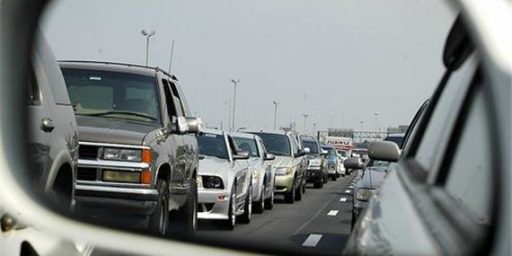Treo Smartphone Beats Radio Traffic Reporters
AP business writer Michael Regan gives the Treo Smartphone’s traffic software a green light.
REVIEW: Traffic Software Gives Radio a Run (AP)
With gas prices at eye-popping levels, Palm Inc.’s Traffic for Treo Smartphones couldn’t have come at a better time. It costs $4.99 a month to get traffic updates for one city — a small price considering savings you’d get by dodging traffic jams and the stop-and-go nightmares that the radio reports euphemistically call “heavy volume.” You can get two cities for $7.99 a month, or all 10 for $14.99. So far, the software covers metropolitan areas for New York, Los Angeles, San Diego, San Francisco, Houston, Atlanta, Detroit, Seattle, Chicago and Washington, D.C./Baltimore. You can download it from Palm’s Web site.
With Traffic, there’s no need to wait 10 or 15 minutes for the next traffic update on the radio. Plus, you avoid radio traffic reporters who have to cram so much information into so little time, they end up sounding like auctioneers on caffeine binges. These reporters typically speak in an incomprehensible jargon, throwing around words like “spurs” and “interchanges” and bridges with names that only traffic reporters know. It’s easy to miss something, then have to wait another 10 to 15 minutes for the next report, only to miss it again.
[…]
Of course, one disadvantage when compared to radio is that you can only use the Treo before you start driving or when you are stopped, unless you have a passenger. The temptation to fire up the software while driving proved too strong to resist at times for me. So if you’re like me, you’ll need to work on your willpower in order to avoid ending up as the centerpiece of a rubbernecker delay yourself.
Since most of us stuck in traffic during rush hour are lone commuters, that is indeed a problem.
In the DC metro area, at least, radio traffic reports are quite annoying. Because the commuting zone stretches 50 miles or so in each direction, covering parts of Maryland, Northern Virginia, and DC itself, there’s simply not enough time to cover all the major routes. Plus, the reporters always seem to feel obligated to devote a substantial amount of their alloted segment telling us that places that always have high traffic (I-270, the Springfield interchange, the Woodrow Wilson Bridge, and the inner and outer loops of the I-495 Beltway) are moving slowly.
It would certainly be worth $5 a month to get more useful reports if they can make it easier to operate while alone in the car. When even a 20 mile commute takes 45 minutes, checking the traffic before leaving is not particularly helpful.





XM offers 24-hour traffic from reporters who speak slowly enough to be understood, use local road names that everyone else uses, and usually (except for a few announcers) avoid stupid stuff traffic catchphrases. XM costs $12.99/month — slightly more than Treo’s service — plus the initial investment of $99 – $199 in equipment, but along with the 24-hour traffic for 23 major markets, you also get a bunch of music and talk channels.
Full disclosure: I work for the company that provides XM’s traffic data.
I enthusiastically second the XM recommmendation. Fulltime around the clock traffic and weather for major metropolitan areas. Sometimes I just for the hell of it listen to the LA and NYC traffic reports to see how they’re doing. But the best thing about XM is the content. The music and comedy channels are great.
You can get the XM Roady 2 with a car kit for under $50 now.
http://www.xmradio.com